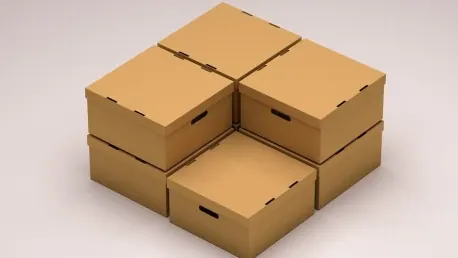The retail e-commerce packaging market is undergoing a significant transformation as sustainability becomes a crucial consideration for businesses globally. With a projected growth from USD 17.6 billion in 2023 to approximately USD 28.7 billion by 2033, the sector’s evolution is driven by the increasing importance of sustainable practices. As e-commerce continues its rapid expansion, the demand for environmentally friendly packaging solutions is set to redefine the industry. Sustainability is no longer a fringe trend but has become an essential component in meeting both consumer expectations and regulatory requirements, substantially impacting packaging solutions in the e-commerce space.
The Role of Sustainability in Packaging
Packaging in the e-commerce industry is moving beyond mere protection and aesthetics as there is a growing emphasis on its environmental impact. Consumers today are more eco-conscious than ever, demanding packaging options that have minimal environmental footprint. This shift in consumer attitude is prompting businesses to respond by adopting sustainable materials and practices. Eco-friendly packaging involves the use of recycled or renewable materials, which helps in reducing waste and minimizing the overall carbon footprint associated with e-commerce activities. Companies are increasingly turning towards biodegradable packaging options, ensuring that the resources used for packaging do not contribute to environmental degradation over time.
These sustainable packaging practices are not only about meeting regulatory standards but also about aligning with the growing consumer preference for green solutions. By focusing on eco-friendly materials, companies are able to meet rigorous environmental regulations while appealing to an expanding market of environmentally conscious consumers. This dual benefit of regulatory compliance and enhanced customer loyalty is making sustainable packaging a critical element for businesses operating in the retail e-commerce space. Moreover, as businesses adopt these green practices, they enhance their reputation, demonstrating corporate social responsibility in a market where consumer values are shifting significantly.
Regulatory Push and Consumer Demand
Global regulatory bodies are tightening their regulations on packaging and environmental standards, compelling businesses to innovate and find ways to reduce their environmental impact. These regulations have made it mandatory for companies to adopt sustainable practices, creating an environment where sustainability is no longer an optional add-on but a business imperative. Compliance with both local and international standards has rendered sustainability a non-negotiable aspect of the packaging industry. Companies that fail to adapt are likely to face not only penalties but also a decline in consumer trust and loyalty.
In tandem with regulatory pressures, consumer demand for sustainable packaging solutions is rising steeply. Environmentally conscious consumers are increasingly favoring brands that showcase clear sustainability initiatives. Packaging that encapsulates these green values plays a significant role in enhancing brand loyalty and customer retention. In a market characterized by intense competition, businesses that prioritize sustainable practices gain a competitive edge, improving their overall brand perception. Such companies often find their sustainable packaging efforts rewarded with heightened loyalty and a positive outlook from consumers, who are becoming ever more vocal and discerning about their purchasing choices.
Impact on Logistics and Supply Chain
Sustainability in the retail e-commerce packaging market extends beyond the materials used to encompass logistics and supply chain efficiencies. Efficient packaging solutions can significantly optimize space usage, reduce shipping loads, and lower transportation emissions, aligning with both economic and environmental goals. This optimization translates into substantial cost savings for e-commerce businesses, contributing to a smaller environmental footprint. The efficient use of packaging materials and space ensures that transportation is streamlined, further reducing the carbon emissions associated with shipping.
Innovations such as custom-fit packaging and right-sizing are becoming increasingly prevalent, helping companies to minimize waste and improve efficiency. Custom-fit packaging solutions are designed to fit products precisely, eliminating the need for excessive materials. Right-sizing involves creating packaging that is just the right size for the product, avoiding unnecessary bulk. These smart packaging designs not only contribute to sustainable practices but also enhance overall operational efficiency. Such advancements are crucial for maintaining both sustainability and profitability in a competitive e-commerce landscape. By adopting efficient logistics and supply chain solutions, companies are able to provide their customers with a reliable service that aligns with environmental values.
Technological Innovations in Sustainable Packaging
Technological advancements are revolutionizing the sustainable packaging landscape in the retail e-commerce market. Companies are leveraging technologies such as augmented reality (AR) to make packaging both functional and engaging. AR can provide consumers with additional product information, interactive elements, and a richer unboxing experience, thereby adding value beyond the physical packaging. Such innovations not only enhance user experience but also underscore a brand’s commitment to leveraging technology for sustainable practices.
Additionally, technology facilitates the development of smart packaging solutions that optimize material usage and reduce waste. Automated systems like the FLX™ SmartPacker by Sealed Air Corporation exemplify how technology can contribute to sustainability. The FLX™ SmartPacker creates custom boxes that fit products precisely, reducing excess material waste and ensuring efficient use of resources. Such systems highlight the integration of automation and intelligent design in achieving sustainability goals. By using technology to streamline packaging processes, companies can significantly reduce their environmental impact while maintaining operational efficiency.
Diverse Product Offerings and Market Segmentation
The retail e-commerce packaging market is characterized by diverse product offerings that cater to various needs and segments. Protective packaging, boxes, mailers, labels, and tapes each serve distinct practical purposes, illustrating the tailored demand within the market. Protective packaging, for instance, is crucial for ensuring that products reach consumers safely and intact. The significance of this segment is underscored by its expected notable growth rate, emphasizing its importance in the e-commerce packaging ecosystem.
Different merchandise types, such as consumer electronics, fashion, and home furnishings, require specific packaging approaches. For example, fashion items often demand aesthetically pleasing packaging designs that align with brand identity and offer an elevated unboxing experience. Consumer electronics typically need robust and secure packaging to protect delicate components during transit. These varied requirements highlight the dynamic nature of the market and the necessity for a wide range of packaging solutions. The complexity of needs across these segments underscores the market’s adaptability and responsiveness to specific demands, fostering an environment of continuous innovation and growth.
Regional Dynamics and Sectoral Insights
Geographical differences play a pivotal role in the evolution of the retail e-commerce packaging market, influencing both demand and supply dynamics. The United States, for example, is poised to dominate the market with a compound annual growth rate (CAGR) of 4.9% during the forecast period. This robust growth is driven by the strong presence of e-commerce and packaging industries in the region. The integrated nature of these industries in the United States facilitates innovations and developments in sustainable packaging solutions, further pushing the market forward.
In terms of merchandise, the fashion segment is set to lead the market with a CAGR of 4.8% by 2033. This indicates a substantial demand for packaging solutions that are both functional and visually appealing. The fashion industry’s emphasis on aesthetics and brand alignment demands packaging that not only protects but also enhances the customer experience. Regional dynamics and sectoral insights provide a layered understanding of the market’s trajectory, revealing how different regions and sectors are contributing to the overall growth of the sustainable packaging market. These insights help in identifying growth opportunities and understanding the varied needs across different markets.
Competitive Landscape and Innovations
The retail e-commerce packaging market is experiencing a major shift as sustainability becomes a key focus for businesses around the world. Forecasts suggest the market will grow from USD 17.6 billion in 2023 to about USD 28.7 billion by 2033. This impressive growth is fueled by the rising importance of sustainable practices. With the continued rapid expansion of e-commerce, the demand for eco-friendly packaging solutions is expected to reshape the industry dramatically. Sustainability has evolved from being a niche trend to an essential element in fulfilling both consumer expectations and regulatory mandates. This paradigm shift is significantly influencing packaging solutions in the e-commerce sector. Companies are now more committed than ever to integrating sustainable practices to cater to environmentally conscious consumers and comply with stricter regulations. This ongoing transformation in the packaging market underscores the broader industry trend towards environmental responsibility, signifying that sustainable packaging is here to stay and will continue to gain prominence in the years to come.









